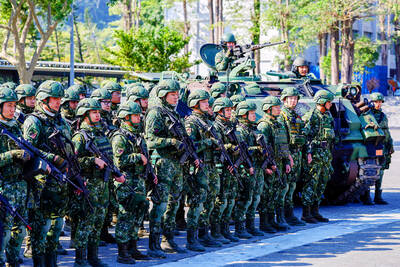New ideas and practices are needed to imporve the Cultural Heritage Preservation Act (文化資產保存法), academics and professionals said at a national forum yesterday, held by the Ministry of Culture to seek public opinions on the nation’s cultural policy.
There are currently 744 designated monuments, 1,031 historical buildings and 42 heritage sites in Taiwan. Since its implementation in 1982, the law has been amended six times.
Taiwan’s way of dealing with cultural preservation is materialistic and focuses only on “objects,” National Cheng Kung University’s professor Fu Chao-ching (傅朝卿) said.

Photo: Liao Yao-tung, Taipei Times
“We spend huge amounts of money restoring buildings, but pay no attention to people,” he said. “It is an elites’ heritage building, since you can’t hear voices from inside.”
National Taiwan University’s Graduate School of Building and Planning professor Hsia Chu-joe (夏鑄九) said this object-obsessed thinking prevents Taiwanese from seeing culture as alive.
“The idea of objects is the origin of Western modernity. This hegemonic discourse views culture preservation in a materialistic manner, as grand monuments,” he added. “Material and non-material cultural heritage is an integral whole. Only the so-called ‘experts’ can’t see it clearly.”
Hsia also said that future amendments to the law should encourage participation from local communities and non-governmental organizations and take into consideration the preservation of collective memories, grassroots identities, traditional living and craftsmanship. Otherwise, it will be difficult to properly preserve sites like Ri Xing Typography (日星鑄字行), one of the last factories in Taiwan to produce traditional Chinese-character lead type, and the Yehyin (野銀) village of the Tao Tribe on Orchid island (Lanyu, 蘭嶼), he said.
Meanwhile, Wang Hui-chun (王惠君), a professor at National Taiwan University of Science and Technology, said the notion of culture as a living thing is important when it comes to preserving Aboriginal cultures.
“We have to think what we want to preserve,” Wang said. “Culture that is constantly changing or items in people’s houses?”
Others urged the government to establish a set of operational guidelines for the implementation of the act so that there are standards for operation.
“When it comes to what to do and how to do things, there is a vast difference among local governments and committee members,” Fu said. “There are many things left unexplained, so people have to make their own decisions that differ from each other and sometimes conflict with international conventions.”
Having been isolated from the international system since its withdrawal from the UN in 1971, Taiwan has a lot of catching up to do to meet international standards, Fu added.
To archeologist and Academia Sinica research fellow Liu Yi-chang (劉益昌), the act reflects a Sino-centric way of thinking.
“Ninety-five percent of the designated historical sites are Han Chinese. Yet Han Chinese heritage only makes up for 1 percent of the human history on the island,” Liu said. “The history of human activities in Taiwan dates back to 50,000 years ago. If we think about it, then we will find the 42 designated heritage sites are far too few.”

UNILATERAL MOVES: Officials have raised concerns that Beijing could try to exert economic control over Kinmen in a key development plan next year The Civil Aviation Administration (CAA) yesterday said that China has so far failed to provide any information about a new airport expected to open next year that is less than 10km from a Taiwanese airport, raising flight safety concerns. Xiamen Xiangan International Airport is only about 3km at its closest point from the islands in Kinmen County — the scene of on-off fighting during the Cold War — and construction work can be seen and heard clearly from the Taiwan side. In a written statement sent to Reuters, the CAA said that airports close to each other need detailed advanced

Tropical Storm Fung-Wong would likely strengthen into a typhoon later today as it continues moving westward across the Pacific before heading in Taiwan’s direction next week, the Central Weather Administration (CWA) said. As of 8am, Fung-Wong was about 2,190km east-southeast of Cape Oluanpi (鵝鑾鼻), Taiwan’s southernmost point, moving westward at 25kph and possibly accelerating to 31kph, CWA data showed. The tropical storm is currently over waters east of the Philippines and still far from Taiwan, CWA forecaster Tseng Chao-cheng (曾昭誠) said, adding that it could likely strengthen into a typhoon later in the day. It is forecast to reach the South China Sea

Almost a quarter of volunteer soldiers who signed up from 2021 to last year have sought early discharge, the Legislative Yuan’s Budget Center said in a report. The report said that 12,884 of 52,674 people who volunteered in the period had sought an early exit from the military, returning NT$895.96 million (US$28.86 million) to the government. In 2021, there was a 105.34 percent rise in the volunteer recruitment rate, but the number has steadily declined since then, missing recruitment targets, the Chinese-language United Daily News said, citing the report. In 2021, only 521 volunteers dropped out of the military, the report said, citing

WEATHER Typhoon forming: CWA A tropical depression is expected to form into a typhoon as early as today, the Central Weather Administration (CWA) said yesterday, adding that the storm’s path remains uncertain. Before the weekend, it would move toward the Philippines, the agency said. Some time around Monday next week, it might reach a turning point, either veering north toward waters east of Taiwan or continuing westward across the Philippines, the CWA said. Meanwhile, the eye of Typhoon Kalmaegi was 1,310km south-southeast of Oluanpi (鵝鑾鼻), Taiwan’s southernmost point, as of 2am yesterday, it said. The storm is forecast to move through central